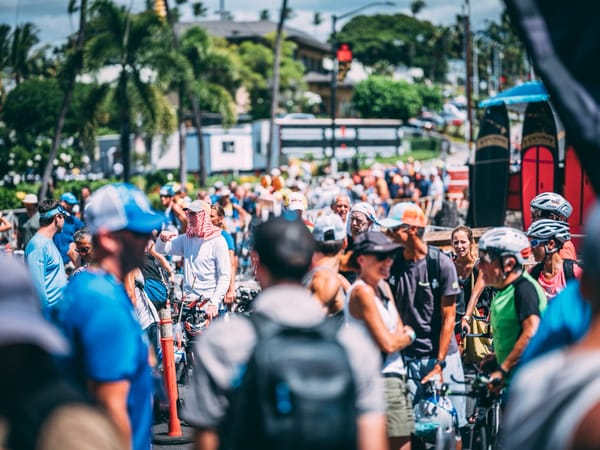Having a Well-Developed Capacity for Fat Metabolism Might Help You Train More
Being a good fat burner may have advantages for long-distance triathletes on race day and may also help us accumulate the large training volumes we need to prepare for those long race days.


We have discussed at length in previous articles how developing an advanced capacity to metabolise fat for fuel during exercise can be useful for long-distance triathletes.
We’ve also published research on it; for example, one of our recent papers showed a relationship between an athlete’s peak fat oxidation rate (PFO) and performance in an endurance trial. The addition of PFO to traditional models of endurance – VO2max, thresholds, and economy – improved the prediction of performance (16). Other labs have shown relationships between PFO and endurance, including Ironman performance (8).
However, something I think is missing from the discussion is how having a robust ability to metabolise fat during training is helpful, specifically during high-volume days with multiple sessions. That will be the focus of this article.
Basics of carbohydrate metabolism
I feel like a bit of a broken record in this one, but during prolonged endurance exercise, we primarily use two fuels to support our metabolism and keep us moving. We have carbohydrates, which are stored as glycogen in muscles and in the liver, and we have fat, stored in fat cells and in muscle. The rate at which we use carbohydrates and fats to support metabolism changes with things like exercise intensity and duration (18, 20), heat stress (7), and recent diet (1, 19).
As a reminder, our carbohydrate energy stores are quite small, typically <3000 kcal (9), with ~80% in skeletal muscle and ~10-15% in the liver (12). By contrast, our fat stores are enormous. As 1 g of fat provides ~9.75 kcal of energy (13), a lean 70-kg athlete with only 10% body fat has ~68,250 kcal of stored fat energy. Theoretically, this might be sufficient to complete more than six Ironman triathlons (14). That’s not to say that all 70 kg athletes with 10% body fat can complete six Ironmans back-to-back, just that we don’t run out of fat energy during training and racing.
This point that carbohydrate stores are limited and fat stores are (effectively) not is important to consider in athletes undertaking serious training volumes. Our limited carbohydrate energy stores are depleted during exercise of sufficient length and intensity, with muscle glycogen eventually running down to low and perhaps limiting concentrations (2, 3, 11). If we complete a training session in the morning – say a 3.5-hour ride in Zone 2, with excursions into higher intensity zones for sprints or hills – we will find ourselves with much lower glycogen concentrations than when we started. This could meaningfully impact the quality of an afternoon tempo run.
We can, of course, rebuild the glycogen stores that are utilised during training after the session is completed (17). However, this process takes time, with carbohydrate stores likely not reaching full repletion for 24-36 hours (5). This is potentially problematic when we finish our long morning ride at 11:30 and are looking to head out for that tempo run four hours later at 15:30. We can use specific dietary strategies to maximise the rate at which glycogen stores are re-synthesised, such as early and aggressive carbohydrate refeeding at rates of ~1.2 grams per kilogram of body mass, per hour (4). These strategies might not, however, be something we want to undertake routinely. For example, aggressive carbohydrate refeeding before a second training session might not work well for all athletes from a gastrointestinal perspective, particularly when that second session is a tempo run.
This is important when considering that the relationship between training volume and performance is undeniable. We will improve performance if we can find ways to increase and fuel our training volume. To some extent, it is a dose-response relationship, the more we train, the better we perform. There is research to support this view, including relationships between training volume and important mitochondrial adaptations to training (10), and between running volume and elite-level running performance (assessed as the IAAF score) (6). However, we need to be able to fuel the work carried out in training. If we train so much that we can’t keep up with the energy (and carbohydrate) demand of training and basic bodily functions (e.g., immune function, muscular growth, and repair), we will likely run into undesirable outcomes such as non-functional overreaching or overtraining. This is where having a robust fat metabolism may benefit by allowing higher volume training over longer periods—food for thought.
How being a good fat burner may help
The degree to which athletes can use fat to support energy metabolism during exercise is quite variable (15). For example, when pedalling at 240 W and a rate of energy expenditure of ~16.3 kcal per minute, one athlete with a more modest fat-burning capacity may be getting 90% of their energy from carbohydrates and 10% from fat, whereas an athlete with very robust fat burning capabilities may be closer to 30% carbohydrate and 70% fat. This would mean the fat burner is using those limited carbohydrate energy stores at a much slower rate, in this example, at a rate of 1.2 vs 3.6 grams per minute, or a third of the rate of the more modest fat burner.
That difference becomes meaningful when we consider backing up big training sessions on the same day. The robust fat burner in the example above must put fewer carbohydrates back in the tank four hours before the tempo run.
How to become a better fat burner
Having a well-developed capacity for fat metabolism during exercise may therefore have acute performance advantages. Still, it may also have advantages for those athletes undertaking multiple demanding sessions in a single day. So, how do you do it? We discuss this in detail in our courses, but here are the key points:
- Training and getting fitter will likely improve your capacity for fat oxidation during exercise.
- Low-intensity training may be particularly important, as during lower-intensity exercise below the lactate threshold, we stress fat metabolism to run at its highest rates.
- Adaptation to a lower carbohydrate diet.
References
- Achten J, Jeukendrup AE. The effect of pre-exercise carbohydrate feedings on the intensity that elicits maximal fat oxidation. J Sports Sci 21: 1017–1024, 2003. doi: 10.1080/02640410310001641403.
- Ahlborg B, Bergström J, Ekelund L, Hultman E. Muscle glycogen and muscle electrolytes during prolonged phyiscal exercise. Acta Physiol Scand 70: 129–142, 1967.
- Bergström J, Hultman E. A study of the glycogen metabolism during exercise in man. Scand J Clin Lab Invest 19: 218–228, 1967.
- Betts JA, Williams C. Short-term recovery from prolonged exercise. Sports Med 40: 941–959, 2010. doi: 10.2165/11536900-000000000-00000.
- Burke LM, Van Loon LJC, Hawley JA. Postexercise muscle glycogen resynthesis in humans. J Appl Physiol 122: 1055–1067, 2017. doi: 10.1152/japplphysiol.00860.2016.
- Casado A, Hanley B, Santos-Concejero J, Ruiz-Pérez LM. World-class long-distance running performances are best predicted by volume of easy runs and deliberate practice of short-interval and tempo runs. J Strength Cond Res 35: 2525–2531, 2021. doi: 10.1519/JSC.0000000000003176.
- Febbraio MA, Snow RJ, Stathis CG, Hargreaves M, Carey MF. Effect of heat stress on muscle energy metabolism during exercise. J Appl Physiol 77: 2827–2831, 1994.
- Frandsen J, Vest S, Larsen S, Dela F, Helge JW. Maximal fat oxidation is related to performance in an Ironman triathlon. Int J Sports Med 38: 975–982, 2017. doi: 10.1055/s-0043-117178.
- Gonzalez JT, Fuchs CJ, Betts JA, van Loon LJC. Liver glycogen metabolism during and after prolonged endurance-type exercise. Am J Physiol - Endocrinol Metab 311: E543–E553, 2016. doi: 10.1152/ajpendo.00232.2016.
- Granata C, Jamnick NA, Bishop DJ. Training-induced changes in mitochondrial content and respiratory function in human skeletal muscle. Sports Med 48: 1809–1828, 2018.
- Hermansen L, Hultman E, Saltin B. Muscle glycogen during prolonged severe exercise. Acta Physiol Scand 71: 129–139, 1967.
- Jensen J, Rustad PI, Kolnes AJ, Lai YC. The role of skeletal muscle glycogen breakdown for regulation of insulin sensitivity by exercise. Front Physiol 2: 112, 2011.
- Jeukendrup AE, Wallis GA. Measurement of substrate oxidation during exercise by means of gas exchange measurements. Int J Sports Med 26: S28–S37, 2005. doi: 10.1055/s-2004-830512.
- Kimber NE, Ross JJ, Mason SL, Speedy DB. Energy balance during an Ironman triathlon in male and female triathletes. Int J Sport Nutr Exerc Metab 12: 47–62, 2002. doi: 10.1123/ijsnem.12.1.47.
- Maunder E, Plews DJ, Kilding AE. Contextualising maximal fat oxidation during exercise: Determinants and normative values. Front Physiol 9: 1–13, 2018. doi: 10.3389/fphys.2018.00599.
- Maunder E, Plews DJ, Wallis GA, Brick MJ, Leigh WB, Chang WL, Stewart T, Watkins CM, Kilding AE. Peak fat oxidation is positively associated with vastus lateralis CD36 content, fed‑state exercise fat oxidation, and endurance performance in trained males. Eur J Appl Physiol 122: 93–102, 2022. doi: 10.1007/s00421-021-04820-3.
- Podlogar T, Wallis GA. New horizons in carbohydrate research and application for endurance athletes. Sports Med 52: 5–23, 2022. doi: 10.1007/s40279-022-01757-1.
- van Loon LJC, Greenhaff PL, Constantin-Teodosiu D, Saris WHM, Wagenmakers AJM. The effects of increasing exercise intensity on muscle fuel utilisation in humans. J Physiol 536: 295–304, 2001. doi: 10.1111/j.1469-7793.2001.00295.x.
- Wallis GA, Rowlands DS, Shaw C, Jentjens RLPG, Jeukendrup AE. Oxidation of combined ingestion of maltodextrins and fructose during exercise. Med Sci Sports Exerc 37: 426–432, 2005. doi: 10.1249/01.MSS.0000155399.23358.82.
- Watt MJ, Heigenhauser GJF, Dyck DJ, Spriet LL. Intramuscular triacylglycerol, glycogen and acetyl group metabolism during 4 h of moderate exercise in man. J Physiol 541: 969–978, 2002. doi: 10.1113/jphysiol.2002.018820.






